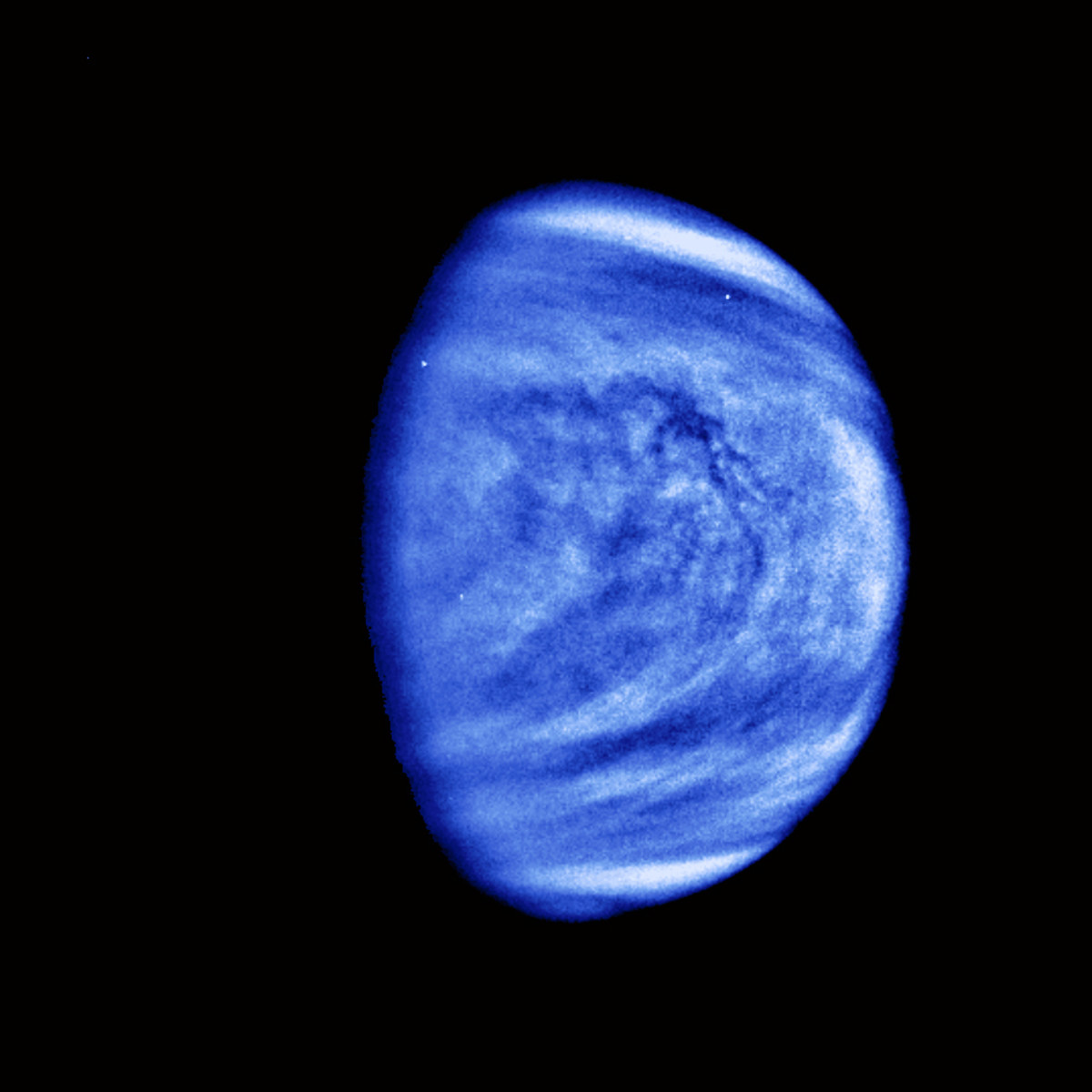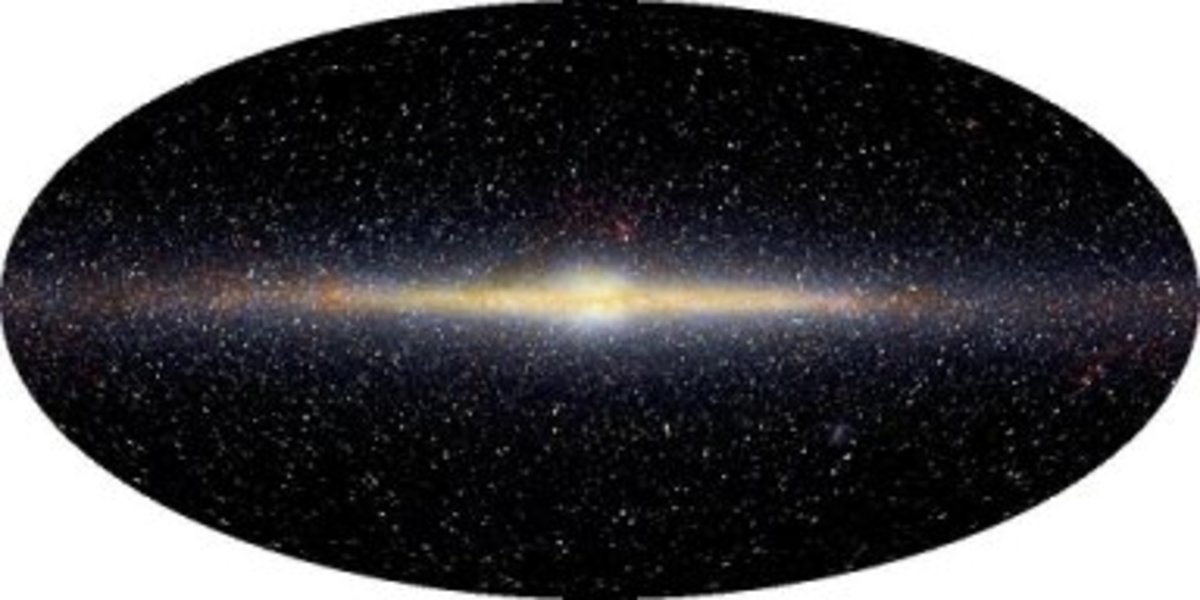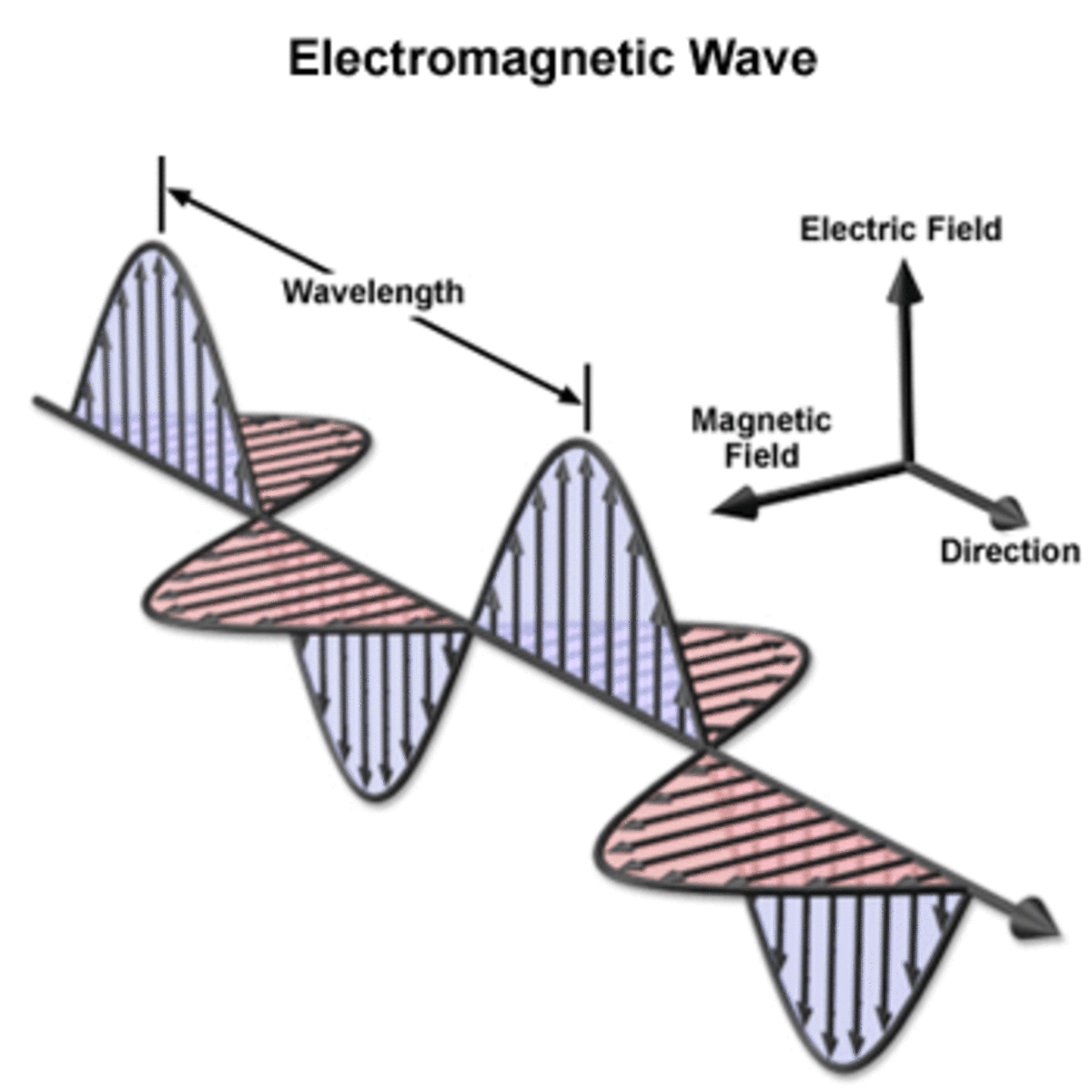Dowsing for Water, pre Exploding Planet Earth and Exploding Galaxies
Dowsing up to some few years back used to be very controversial to such a passion that it inspired big money intrigue, up to at least 1.1 million dollars intrigue on one occasion.
The magnificent sum had been offered as payment to anyone for proof in the validity of dowsing by a known educational institution (in "Dowsing Data Defy The Skeptics", reference#_pa1 under 'Printed references' at the end ). There seems to be no similar excitement regarding the matter lately, although dowsing believers apparently had steadily increased in number over the years and had organized.
Dowsing may have gained some respectability from the favorable results of a 10-year period study conducted by respectable German institutions (reference#_pa1) and published in the "Journal of Scientific Exploration" through Stanford University.
As surmised by the research group's head (Hanz-Dieter Betz, physicist at the University of Munich), changes in the electrical properties of rock and soil due to water flow that somehow were detectable to dowsers may account for their results.

Dowsing various tools

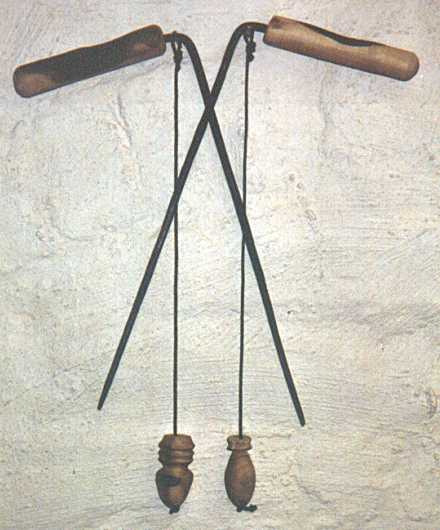
The tools for dowsing, like the traditional forked branch familiar to many, may contribute to an image for the practice suggestive of charlatanism or quackery (branches my easily be associated with the witch doctors of simple, including modern quacks). By appearance the tools themselves look too simple to be affected in any way by mere presence of water deep underground, unless moved somehow by the wielder.
On the other hand these tools or their important parts possibly may move in some certain fashion due to influences of electromagnetic forces in the vicinity, and/or due to movements of internal electrical charges caused by external influences.
Electrical elements like electrons may be brought through Earth's crust to the vicinity after being stripped from substances in water passages (like the said rocks and soil) then inducted to vertical movement by natural magnetic field fluctuations (see "Natural Flying Saucers that Fly by Natural Magnetic Fields" in reference#_wa1 under 'Web references' at the end). Horizontal magnetic field lines perpendicular to the vertical may induce the movement.
Besides electrical elements, ionized water particles may also be induced to move along the same path, resulting to a wet but improved conducting medium for flow of electric current or electricity (a particle of ordinary substance, like water, is ionized through loss or gain of one or more of its orbiting electrons, leaving an electrically charged particle that is either of two types: 'positive ion' or 'negative ion').
Ion particles from solids in passageways, as well as electrical elements, may also follow the water's normal course, to be induced later somewhere else by fluctuations in Earth's magnetic field.
A much different way for detecting underground water that requires little human touch could provide clue to how dowsing by forked branches or other human wielded tools might work. It may be used preparatory to digging wells in areas where normally many split coconuts are available (maybe in copra producing areas).
Using dried empty coconut halves (and/or shells), a number of them may be distributed in an area (the peripheries of the area may suffice) some distance apart from one another, and so positioned that the open part is towards the ground.
Those that gather moisture on the inside after some period may indicate the best spots to dig wells (the method had been described to this writer by rural folks and likely modifiable using other more readily available materials).
Moisture concentrated in a small area on the surface could mean that water traveled vertically up from an underground source with minimal spread or loss to the sides,suggesting of some influence that acted on the fluid upwards.
Ionized water particles as well as other electrical charges (other ionized substances and/or electrical elements) may move on a vertical path that is effectively conductor for electrical charges like the familiar electrical wire that conduct electricity.
Fluctuations in horizontal magnetic field lines as subjected to the electrical charges may occur regularly as well as randomly due to various causes internal or external to Earth and could have vertical effects on the charges.
The regular induction may be caused by different rotational speeds between Earth's crust and magnetic field (see "Geomagnetic Reversal and its Effects", reference#_wb4). The vertical conductor time to time may cut across one or more of Earth's pole-to-pole horizontal magnetic field lines and be subjected to fluctuating magnetic field strength as proximity to crossing point vary.
Random induction may happen through influences on Earth's magnetosphere by external factors in space like the sun as well as other things or forces in the universe.
The subjecting magnetic field fluctuations may induce electrical charges including ionized particles of water to move up or down in the vertical conductor through the same principle that moves electrical charges in the wiring of an electric generator's rotating member.
Direction of magnetic field lines is one of three factors that determine if the electric charges move up or down in the conductor (by convention it runs from the north pole to the south pole of magnets).
This direction (magnetic field lines) may be along Earth's horizontal pole-to-pole line for a field generated by the planet's internal magnet (which has its north pole at the southern hemisphere and its south pole in the northern hemisphere, resulting to magnetic field lines that run from Earth's southern part to the northern part).
The magnetic field generated due to other causes including random external influences could be more complicated. Possibly the resulting magnetic field lines may form loops, with both north and south directions in the horizontal plane.
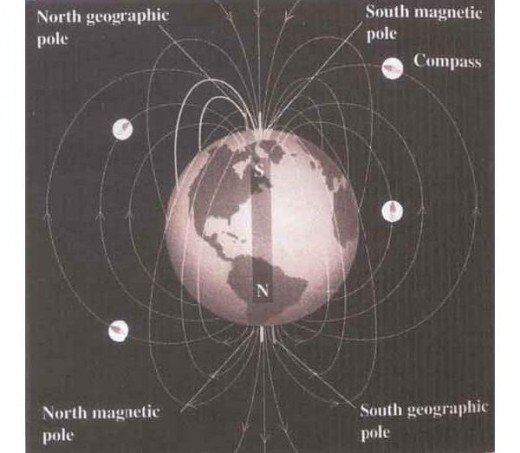
Right-hand rule
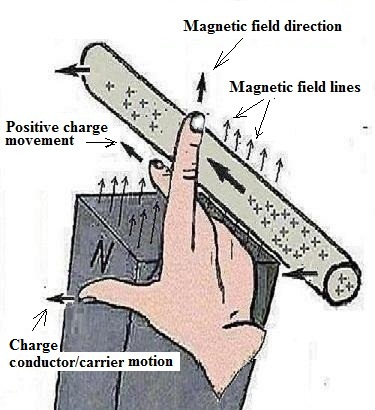
The horizontal direction of the the verical conductor while cutting across magnetic field lines also influences the direction of electrical charges moving vertically. This horizontal cut is the result of Earth's rotation.
The third factor influential to electric charge movement direction is the type of charge ( positive or negative).
Electric charges that are positive move along the vertical conductor in a direction indicated by an electrical pointer called "right-hand rule", otherwise (if negative) the charge direction is indicated by the "left-hand rule" pointer (reference# wc1).
The "right-hand rule" or the "left-hand rule" uses three fingers (thumb, index finger and middle finger) of the hand to point in three dimensions, with the middle finger bent perpendicular to the palm and all fingers perpendicular to each other.
The index finger indicates the direction of magnetic field lines, the thumb the direction of conductor movement, and the the middle finger the direction of electrical charge flow.
The "right-hand rule" is often encountered in electrical work involving devices with electrical wiring that rotate in a magnetic field, like electric generators and motors. Currently the convention for conventional current is that the moving electric charges are positive (in "Right Hand Rules", reference#_wc3), making the "right-hand rule" applicable (both positive and negative charges may move in opposite directions).
(Conductor motion may relate to a tendency of electrical charges moving through the conductor to circle around magnetic field lines. For electrical devices like generators conductor motion moves electrical charges, while in motors moving electrical charges result to conductor motion. The tendency may exist also in moving electrically charged objects, or carriers of electrical charge.)
Right-hand-grip rule
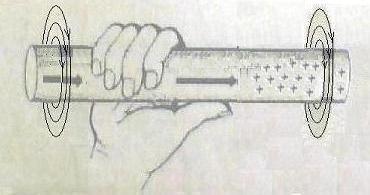
Left-hand-grip rule
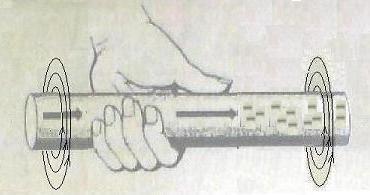
Dowsing items
(A variation given at reference#_wc2 that do not consider conductor movement is called "right-hand-grip rule", where thumb indicates flow of positive charges in conventional current, and curled fingers indicate magnetic field lines direction around the conductor. It may be complemented by a "left-hand-grip rule" for negative charges. In an older convention of negatively charged current flow, "left-hand rule" was also used for current in non-moving conductor).
The ionization process due to water flow may rub off orbiting electrons from one kind of substance and paste rubbed electrons to another kind, making positive ions in the former substance and negative ions in the latter. Negative electrical charges may move vertically in one direction while positive charges may go the opposite way when induced by horizontal magnetic field line fluctuations.
The passageways and retained waters would have one electrical charge, with charges (generally water ions) that may move up or down, balanced maybe eventually by opposite charges that move in the opposite direction.
Considering magnetic field pole-to-pole lines, the right hand may be used palm up so that the index finger points to the south magnetic pole (in the northern hemisphere) indicating magnetic field direction, with the thumb pointed east to indicate the vertical conductor moving with Earth's revolution (west to east movement).
The middle finger pointing up that shows electric charge flow indicates the movement of positive charges upwards to Earth's surface.
The left hand may also be used but with palm down for the thumb to point east and with index finger pointing north. The middle finger now points down indicating downward movement of negative charges.
Magnetic field lines that may loop on the horizontal plane (for random external space influences) have both north and south directed magnetic field lines. Electrical charges may alternately change vertical direction on the conductor with each encounter between horizontal loop part and vertical conductor while Earth rotates.
Electrical charges that covered considerable vertical distance could have been induced mostly regularly by the pole-to-pole horizontal magnetic field lines, unlikely with looping lines.
Thus electrical charges that reach surface may mostly be positive, though negative surface charges may also be possible for looping lines in special conditions, likely with shallow water sources. Repelled by similar charges below surface charges may be ejected out and ionize molecules in the vicinity above, including a dowsing branch.
Charged, the branch (in effect an electrically charged object that moves horizontally west to east with Earth's revolution) may swerve vertically at encounters with horizontal magnetic field lines (either pole-to-pole or looping lines).
The action is similar to conductor motion for wiring conducting electrical charges in the rotating part of an electric motor.
Referring to the right-hand rule for positively charged branch, palm and bent middle finger may be directed east with index finger pointing north, making the thumb point down to indicate downward motion of the branch.
Charge concentration may be higher at the branch tip than at the two ends held by the dowser, subjecting the tip to greater downward pressure than the other ends.
(Electrical charges and Earth's magnetic fields may also be at work though possibly involving other different factors in the case of dowsing for other things, like underground deposits of valuable metal ores like gold or silver.)
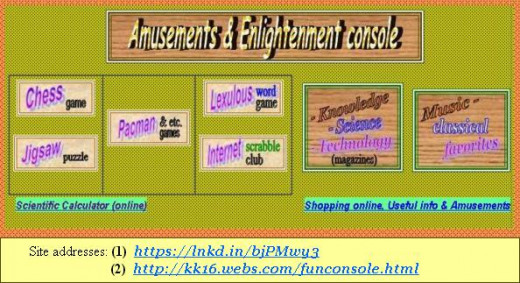
Plasma and ions spout at Earth's poles
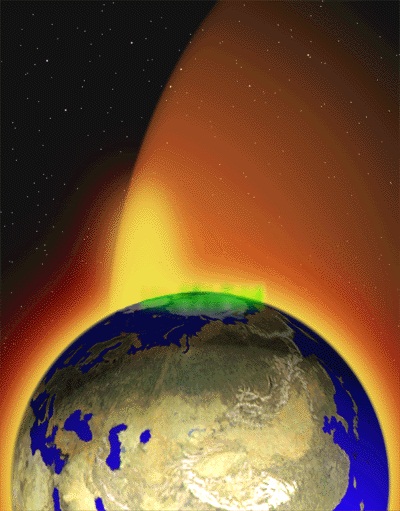
The vertical movement of ions on opposite directions for each kind of charge may in time stratify Earth to an outer partition and an inner partition with opposimg charges.
Once mechanisms activate, charges and processes may be enhanced by considerable ions that may come from other sources in space external to Earth, generally from the sun that every few decades or so undergo magnetic pole reversals (reference# wb1).
This could result to extremes in the concentration of partitioned charges, although chances are, it mostly may be the inner partition that strengthens. Charge partitioning factors within Earth may absorb ions from space of the same kind of charge as the inner partition, but may keep the oppositely charged ions (if not repelled by outer partition) to a relatively smaller mass closer to peripheries.
Variations in charge partitioning factors may time to time cause the ejection or re-absorption of the outer partition's ions, while the inner partition may mostly accumulate its ions to high capacity.
Rotational characteristics in the vicinity of the poles may have less tendency there for separating charges to respective partitions, and considerable ions from Earth's interior may escape through the area.
As indicated by the "right-hand rule" and the "left-hand rule" for flow of underground water ions, positive ions may currently move to Earth's higher levels that have a lower charge capacity, while negative ions move down to greater charge potential.
A negative overall charge for planet Earth may now exist, revolving in effect on a loop around an axis through the planet's magnetic poles, moving approximately west to east.
Positive/negative looping ions & magnets generated

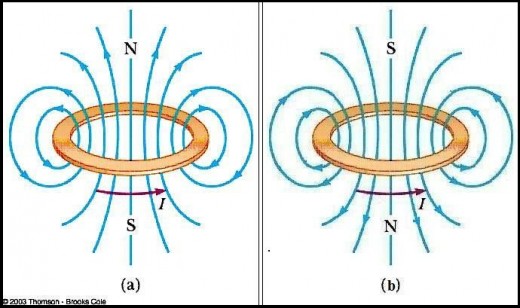
Earth's magnetic field generation
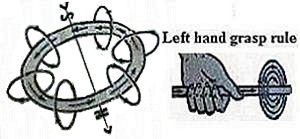
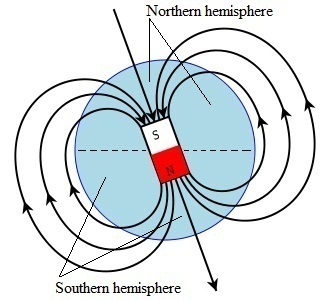
Electricity and magnetism
Revolving electrical charges may generate magnetic fields with north and south magnetic poles (like ordinary magnets) at opposing ends in the axis of revolution. The generated magnet's strength increases with increase in quantity of revolving charges (all other factors assuming unchanged).
Its effects and characteristics are similar to that of current in a conductor bent into a loop, or in conductor coil around electromagnets: a magnet may be generated with strength that increases with increase in the number of loops or coils.
Earth's magnetic poles and the geographical axis are misaligned at a certain angle, and may be due at least to electrical charges in the interior revolving about an axis different than that of the crust.
The solid core over a period may get a charge opposite that of the outer partition (which include Earth's surface). The former's kind of charge at the highest level may be forced downwards through liquid (or solid) interior regardless of Earth's magnetic field lines direction.
With the inner partition currently negative and magnetic field lines going towards the northern hemisphere, application of the left hand rule (ion conductor moving west to east with Earth's rotation) would point the middle finger down, indicating movement of the inner partition's negatively charged ions downwards to Earth's center.
With reversed magnetic poles, the inner partition would be positively charged and magnetic field lines reverse direction towards the currently known southern hemisphere. Applying the right hand rule in this case would also indicate ions in the inner partition moving down to center, but positively charged this time.
A rotating core that is negatively or positively charged would have explosive tendencies as indicated by application of the left/right hand rule described below (this is in addition to three other explosive forces listed following the descriptions).
A rotating negatively charged core would have negative charges moving west to east indicated by the left hand's middle finger bent to the east (left palm turned east). With the index finger pointing to magnetic south pole in the northern hemisphere, the thumb indicating motion of conductor (core materials) would point up indicating explosive force on the core.
At magnetic pole reversal, the magnetic field lines would reverse towards a south magnetic pole that would be then at the currently known southern hemisphere, accumulating positive charges at the core. The right hand rule may be used then with the middle finger bent east (palm facing east) indicating movement of positive charges and with index fingers pointing towards the current southern hemisphere. Again the thumb points upward for movement of conducting core materials.
Electric motors
The above type of explosive force (force-A) might be classified as of a mechanical type (considering prevalent result) like the output of ordinary electric motors. It may be anywhere in Earth's interior wherever revolving electrical charges may exist.
The power of Earth's force-A however, while mechanical in nature has potential to attain extremely high limits, as its energy source (Earth's total rotating charges, both positive and negative combined) may increase to an indefinite very high value.
The mechanical power attainable may be deduced from the power that could be outputted by electric motors inputted with electric power.
Electric motors (the very large ones) may convert electrical energy input to mechanical energy output reaching efficiency percentages to the higher part of the 90's. The small energy percentage with no useful output represent losses converted to heat.
Earth's electrically charged inner partition and outer partition together may produce another type of explosive force (force-B), generally passive because of charge partitioning factors, but in the long run may build up power that when activated have much to contribute for an exploding planet Earth event.
The setup's explosive possibilities have similarities to an electrical capacitor with its two partitioned electrical charges that somehow short-circuited.
The boundary of the two partitions where force-B could manifest may have definite physical physical characteristics, possibly the region between two substances of different densities, or else between two different states of matter (or maybe not necessarily, although definite characteristics are easier to define and analyze).
Electric capacitor
Electrical instruments
That boundary may exist almost anywhere in Earth's interior, from the crust down to the core. Force-B could be powerful there at abrupt changes in conditions for charge partitioning factors.
The crust (or vicinity) though could be a very likely location for the boundary, being a source of oppositely charged water ions. Other ions in lower levels below that might be produced by similar mechanisms may not retain charges long in their environment.
Force-B likely would show up during geomagnetic reversals, although it could also activate whenever either or both inner and outer partitions built up sufficient charge to short-circuit against charge partitioning factors.
The third type of explosive force (force-C) like the preceding two has considerable contribution to provide for an exploding planet Earth event, but unlike the two its action has no direct connection with magnetic or electrical influences.
A good part however of force-C (the intense heat at Earth's interior) may itself be a product of magnetic factors (reference# wa2, titled "Natural Flying Saucers at Pre-exploding Planet Earth").
Two other forces have also power to contribute for exploding planet Earth, although by themselves may not be as powerful to produce results as the preceding three. Force-A on the other hand may assist them to maximize their potentials.
The power of the fourth force (force-D, of mechanical type) derives from the nature of things with the same kind of electric charge to repel one another.
The ions that could compose Earth's interior however may not be as powerful, weight for weight, as substances made up of pure charges, like plasma composed entirely of particles with the same kind of charge (if that were possible). Ions get their charge only when the atoms that compose them acquire or lose extra electrons.
The brute power of force-A could help force-D in this respect, by compacting similarly charged substances as closely as possible against the repulsion of their composing particles until repulsive forces are great enough to counter compaction.
The last force (force-E) is the more common and unobtrusive type better known as "centrifugal force".
Its power could also increase with the compaction given by force-A as the procedure would locate more revolving mass on a higher level where faster speed may have higher energy potentials.
It is mechanical by nature with the type of power that may reinforce the compacting action of force-A against the repulsive power of force-D.
Force-A's compacting activities that get additional mass from below further may be bonus for force-C, by reducing pressure on that part where mass is removed.
At lower pressures, heat energy from force-C may make certain solid levels (or parts of it) fluid, including places where fluid strata may not be expected to exist (like at Earth's inner core).
Hydraulic pressure (a mechanical action) against covering solids above fluid strata could enhance force-C's explosive power.
An exploding planet
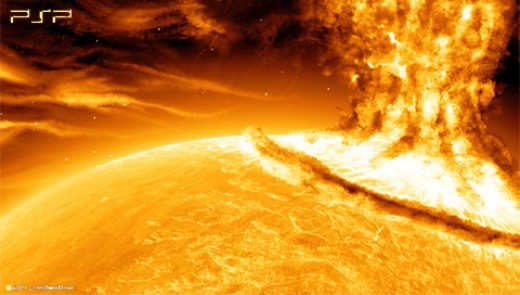
Galaxy magnetic contour, 2 maps (edge/flat views)
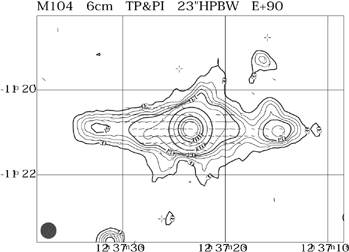
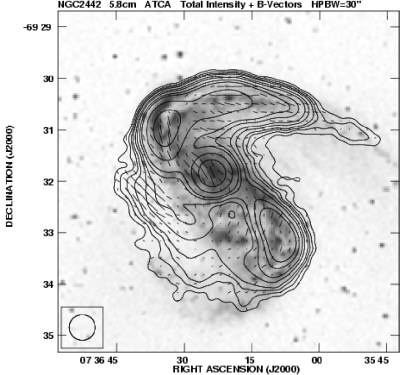
Exploding planets may look like the events are big enough to require the full participation of all explosive forces, especially of the major ones like force-C. Unfortunately (for planet Earth), less power seems sufficient to do the job.
An old scientific article (a reference for exploding planet hubs) hints of a broader scale where force-C may be absent, through evidence from the Dutch astronomer Jan Oort indicating that astronomical stuffs the size of galaxies also explode - events that don't look like molecular heat agents play a part.
Well, galaxies may rotate, and overall may be electrically unbalanced, differing with the neutral state anywhere from slight to high variance, which would result to some net charge that move in a revolving loop around the galaxy's axis.
A central magnet (like Earth's magnet) may then manifest along the axis of revolution and perpendicular to the plane of the loop (or perpendicular to the galactic plane for spiral galaxies or similar shapes).
As potential victims of force-A and cohorts, an attractive aspect of galaxies is their elemental particles of stars that always shoot off charged fluids in the form of plasma and ions of various substances.
Like the water ions of preexploding planet Earth, orbiting charged fluids within galaxies may be induced to move vertically downwards or upwards (depending on kind of charge) relative to the prevailing center of gravity, which (for galaxies), may be the galactic center.
In due time a galaxy, like Earth, may be stratified to an inner partition and an outer partition with opposing electrical charges. Stars and other elemental particles of the galaxy in both partitions may absorb the vertically travelling charged fluids, fixing the opposing chargies on more stable bodies.
The "short-circuited capacitor" effect through force-B may often occur on galaxies, as stars in all galactic levels may shoot off charged fuids that ultimately move to the respective partitions, with the effect set off when vertically travelling fluids of opposite charges attract each other and meet.
Stars likely may not be much affected by a galaxy's megnetic fields and could travel anytime they feel like it, anywhere, so may also set off force-B WITH even more spectacular events.
Force-B explosions though, generally may be chancy affairs, even with the attraction between opposing charges considered.
The explosive forces that may contribute continuous power to explode astronomical stuffs are forces A, D & E; and all result to mechanical explosions. Their powers may increase indefinitely with increase in rotating positive and/or negative charges in the astronomical stuffs.
Astronomical stuffs the size of planets may also expect the regular explosive presence of force-C, and if they explode mechanically only the spectacle may not be observed from astronomical distances.
Even in the case of galaxies, Dutch astronomer Jan Oort in reference# pb1 was not so conclusive (that was of course in the harder times of a past century; current astronomers that see more with better equipments are more conclusive).
(All these brings up the fact that the Solar System also rotates with the prospect that at least one orbiting mass in its inner partition, namely Earth as well as possibly including the revolving sun, could have a negative net charge. This hub though has a long title so here it must end.)
Exploding galaxy 2 diagrams (flat/edge views)
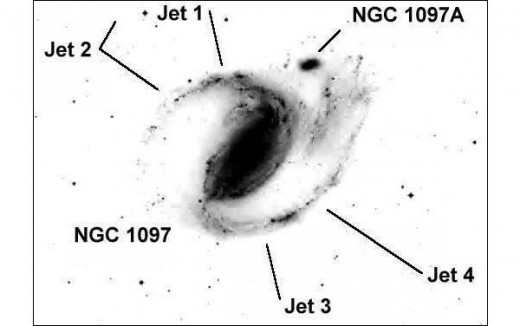
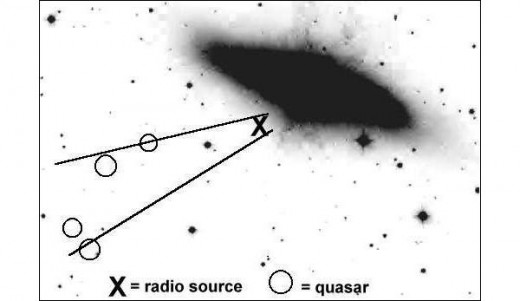
Galactic fountain
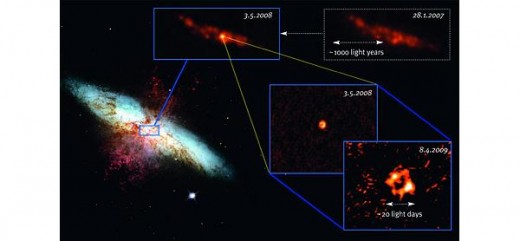
Web References
- wb3.. Electrical mechanics of Water dowsing
(water dowsing effects and its natural causes abstracted from this hub for better presentation)
- wc1.. Right-Hand Rule > ENGINEERING.com
(note: "right-hand rule" for flow of positive charge, "left-hand rule" for flow of negative) - wc2.. Right-hand rule - Wikipedia, the free encyclopedia
- wc3.. Right-hand Rules
(note: conventional current is positive charge)
- we1.. Journal of Scientific Exploration
(from reference# pa1- scientific journal published at Stanford University)
Printed references
pa1.. Dowsing Data Defy The Skeptics
(article in 'Popular Mechanics' magazine for Dec.1998, by Jim Wilson)
pb1.. Exploding Planets
(article in 'Science Digest' magazine for Apr.1982, by Thomas Van Flandern)







